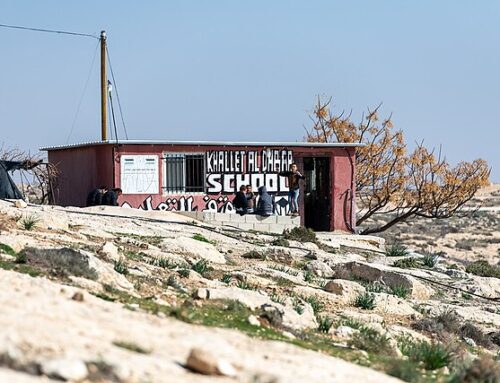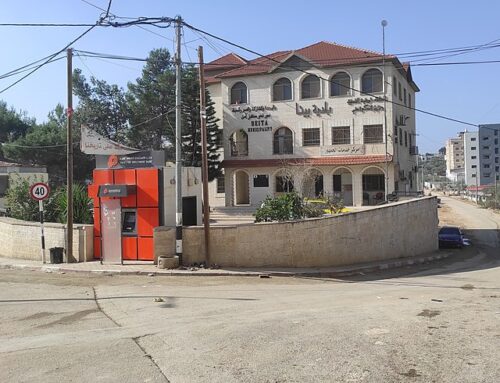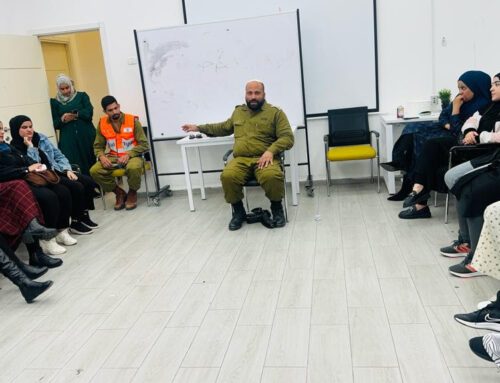 Part I of a four-part Israeli television series, “ON THE LEFT (the story of the Israeli Left 1948-2012)“, was showcased Nov. 9 and 11, at the Other Israel Film Festival in New York. Each of the many films and TV programs featured were co-sponsored by one or more progressive Jewish group. And this one was ours this year. PPI’s representative chose this film on the basis of viewing a limited excerpt.
Part I of a four-part Israeli television series, “ON THE LEFT (the story of the Israeli Left 1948-2012)“, was showcased Nov. 9 and 11, at the Other Israel Film Festival in New York. Each of the many films and TV programs featured were co-sponsored by one or more progressive Jewish group. And this one was ours this year. PPI’s representative chose this film on the basis of viewing a limited excerpt.
It’s described in the festival’s brochure as a documentary on the history of the Israeli left. Instead, it’s a far-left polemic against the idea that there ever was an Israeli left; as I recall, its title in the opening credits even appears with a question mark: “An Israeli Left?” Rather than raising serious issues for careful scrutiny, it’s an unrelenting attack on Israel’s left-wing legacy and the notion that there’s any justice to Israel’s creation and existence.
It’s too bad there wasn’t a panel afterwards, including one or more people who could reasonably critique the film. Rather than introducing an independent voice, both presentations concluded with appearances by Anat Saragusti, the film’s researcher. In the Q & A at the downtown venue, she responded politely to my friend’s concern that the film had a predetermined ideological agenda, claiming that they simply went where the facts led them.
Fellow blogger, Hillel Schenker, provided this perspective from his home in Tel Aviv:
I saw the series when it was broadcast on Channel 8 on Israeli TV, and it is very problematic, coming at the left from a critical Mizrahi [indigenous Middle Eastern Jewish] viewpoint, shared by filmmaker Ron Kahlili and researcher Anat Saragusti. I said this to the director of the Rosa Luxemberg Foundation that supported the film, and she told me that they just provided funding and are not responsible for the contents. It contains some valuable interview material, and some of the criticism is justified, but the film clearly presents an anti-Zionist left perspective, and in my view downplays and frequently ignores the authentic achievements of the Zionist left, and the central role it played in establishing and maintaining the State of Israel during the first decades of its existence.
As Hillel states, there is much to criticize in Israel’s history from a left-wing point of view. Yet the nature of the “left” that the filmmakers champion is puzzling. Were they indicating a fall from grace in early snippets of May Day parades and the like, with marchers holding aloft portraits of Marx and Stalin, or were they making a satirical observation?
Wherever left-wing parties have been in power or significant forces in government, there has always been a gap between the official rhetoric of social justice & equality and their achievements. In some cases, political and social realities have limited what progressives hoped to achieve. In other instances — generally including the most stridently left-wing of movements — this gap is enormous; grand rhetorical flourishes and symbolic gestures have covered up glaring inequities and even mass crimes — as in most countries governed by Communist (or what some people prefer to call Stalinist) parties.
The film scornfully dismisses David Ben-Gurion (Israel’s founding leader and first prime minister) as a phony leftist, and not without reason. His Mapai party, and the Rafi splitoff that he led for a few years in the 1960s with Moshe Dayan and Shimon Peres, courted the US and the West in the Cold War. Personally, I don’t think this was terrible, but one can also reasonably argue in favor of the more left-wing Mapam party’s preference for Israel to join the “neutralist” or “Non-aligned” camp in the Cold War. But the differences between Mapai and Mapam on this point are not even mentioned.
Eventually, Mapam lost much of its identity and its following (it had been Israel’s second largest party, after Mapai) by allying with Labor in what came to be known as the Labor Alignment — not a merged entity, but a joint national electoral list for the Knesset. In the early 1970s, Mapam hinted at a desire to negotiate with the PLO with its Shemtov-Yariv Formula. After it broke with Labor in the early ’80s by opposing the Lebanon War from its outset in 1982, it was reduced to minor party status, electing only four MKs in 1984. In the following decade, Mapam teamed up with Shulamit Aloni’s Ratz (Civic Rights) party to form Meretz.
Mapam is scorned as also faux leftist, partially because a number of its affiliated kibbutzim were built on lands that had belonged to the 400 Palestinian villages destroyed during and after the 1948 war. In a scene repeated more than once, elderly kibbutzniks discuss what happened in 1948, with some in denial, another proudly owning what he did, and still another admitting some shame. What is absent from the film is that the armed belligerence of Palestinian forces had something to do with the Nakba, the catastrophe suffered by Palestinians with Israel’s birth.
Ben-Gurion and Mapai (the largest faction that merged with Rafi and Achdut Ha’Avoda to form today’s Labor Party in 1968) clearly were nationalist — a cardinal sin according to the filmmakers. Ben-Gurion can be blamed (or not) for allying with the then-moderate religious Zionists and liberal centrists, rather than building a socialist majority with Mapam and the Maki (Communist) party.
B-G’s governing philosophy is sometimes described as “statist” rather than socialist, the building of a strong central state authority to defend the country, build-up its economy and absorb great masses of immigrants. The fact is that Israel’s early economy was heavily collectivist, largely based upon agriculture and industry owned by cooperatives and communes, with state investments and subsidies. The Likud government starved the kibbutz sector of credit in the 1980s, and the general economy was heavily privatized in the 1990s, by both Labor and Likud governments.
An integral part of the country’s collectivized infrastructure was formed by the Histadrut, Israel’s central trade union confederation. The film makes much of the contradiction between the Histadrut as the owner of industrial enterprises (i.e., the employer) and as a union representing its workers. It illustrates this by discussing a strike of dock workers in Haifa in the early 1950s that was broken when leading strikers were called up for army service. This is a point worth examining, but the issue’s complexity is given short shrift, ignoring the important role of the Histadrut in creating the enterprises that gave the workers their livelihoods.
The Histadrut also provided its members with comprehensive health care and, in some instances, educational opportunities and cultural programs. In today’s more privatized and corporate economic environment, there is much less of a conflict of interest, but whether most workers have benefited from this neo-liberal economic direction is eminently debatable.
Finally, there’s the question of what happened to the Mizrahim, the Afro-Asian Jews who immigrated massively from the Arab and Islamic worlds in the 1950s and ’60s. The film concentrates on the experience of one elderly couple living in Kiryat Shmona, along the Lebanese border, who arrived as children. I didn’t catch all of the details, but the man explains that his father’s livelihood had to do with living in a port city; therefore, they asked to settle in Haifa or another port. Instead, they were dumped into Kiryat Shmona, then one of numerous “development towns” on the country’s borders and periphery. He said that his father lost his sense of self-worth, because he could never again make the kind of living he had before.
This economic displacement, as well as the cultural and social discrimination they encountered, made the Mizrahi absorption into Israel painful, and embittered this population against what then was Israel’s Labor-Zionist and Ashkenazi (European origin) establishment. These circumstances helped make this mostly blue-collar population a voting base for the main political opposition, the right-wing Herut party of Menachem Begin, and eventually made its successor Likud party the dominant governing force for most election cycles since 1977.
But as I viewed the elderly couple sitting in their Kiryat Shmona apartment, I was struck by how nice it looked. Like many (if not most) Mizrahim, these people have struggled and then succeeded in Israel. And there’s no real consideration given for the massive logistical problem that the young Israeli government had in those years to absorb and acculturate waves of immigrants from countries with very different cultural norms and traditions. Mistakes were clearly made, some of them emanating from prejudice, but there’s also a high rate of intermarriage today between Mizrahim and Ashkenazim, and a significant measure of progress for Mizrahim, even as there’s still a ways to go.
View this six-minute YouTube for a preview of the entire series:






Is this the same Anat Saragusti who directs BTselem USA?
Not according to this Wikipedia bio on her: http://en.wikipedia.org/wiki/Anat_Saragusti. Nor was she introduced as such.